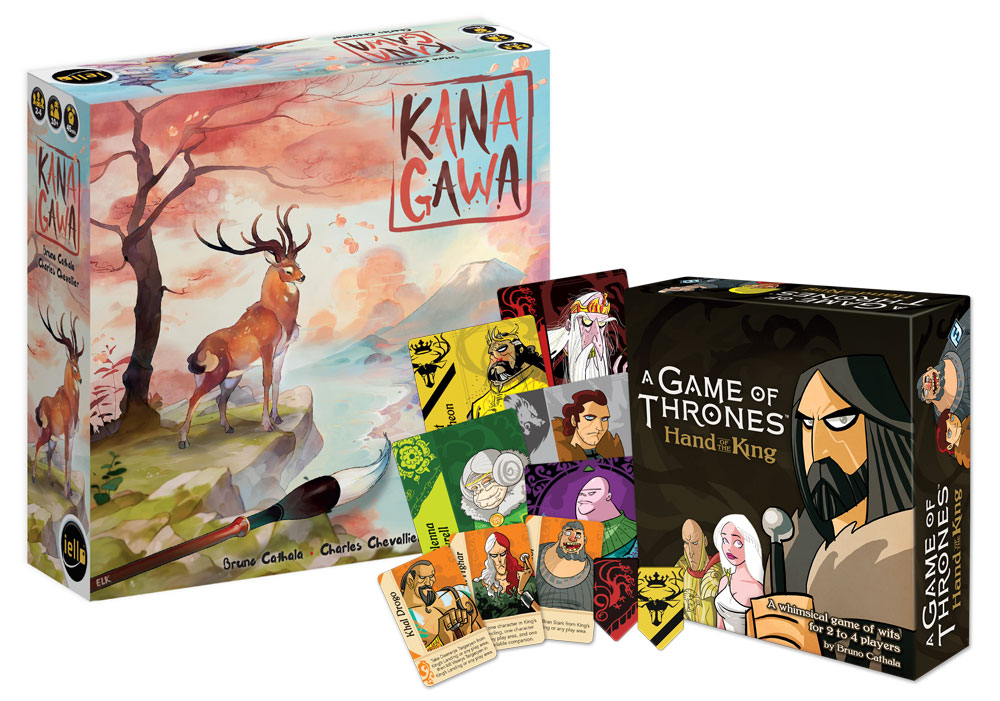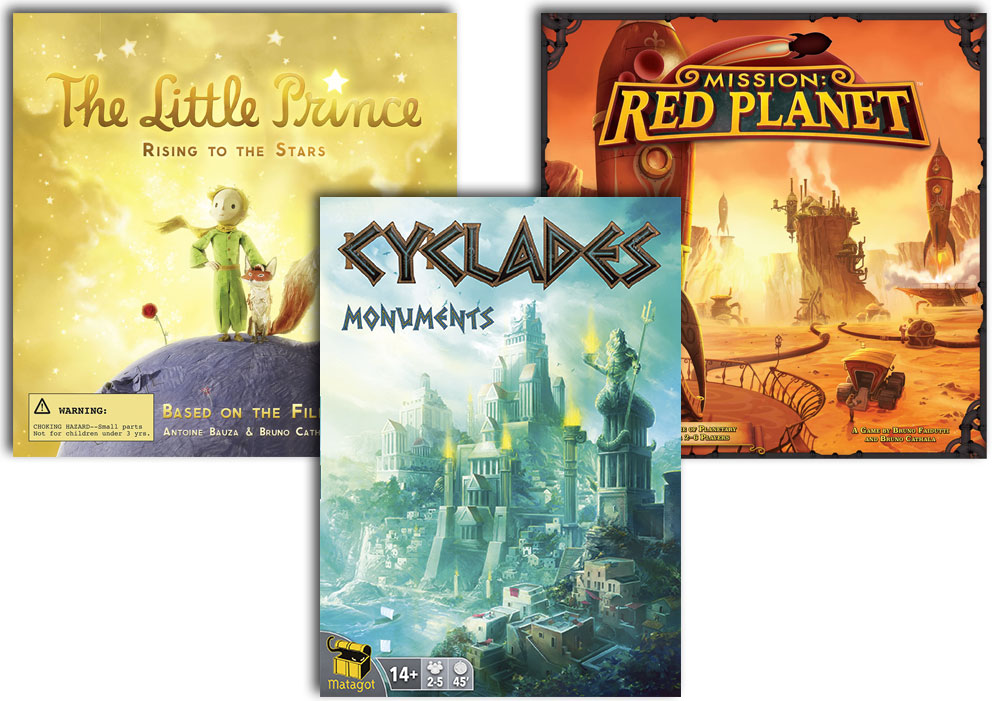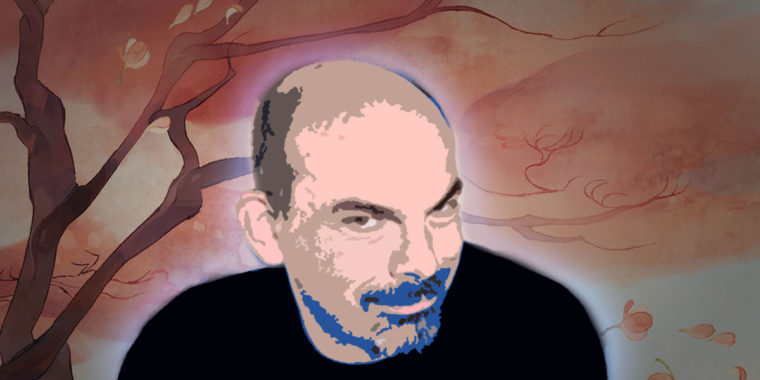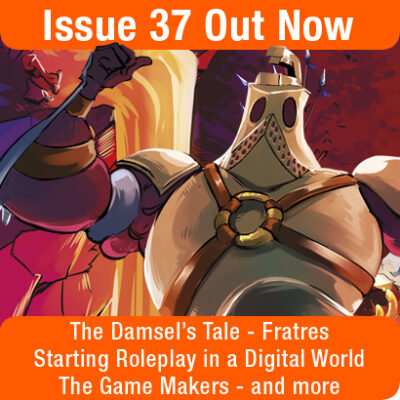With the recent release of Ishtar: Gardens of Babylon game designer Bruno Cathala again makes a notable entry into his legacy. Find out more about the popular game creator in Issue 19. The issue is still available as digital download or in limited print stock.
Interview by Matthew Lee
Very few games designers can be described as ‘prolific’. French game designer Bruno Cathala is one of those people. For over a decade he has been designing games of impressive depth and originality. Some of his published games are considered mandatory experiences for all tabletop players, and include titles such as Five Tribes,Cyclades and Shadows Over Camelot. This issue The Campaigner talks to Bruno about how he got started in game design, and his current role in the industry.
How long have you been working as a game designer? When did you start?
I began to work on my first prototype in November 1999. My first released games came on the market at the end of 2002. From 2004 to 2013, I worked half time on my own games, and half time on side jobs dedicated to games (seller in a game shop, animation, development for publishers, etc.). I’m working full time on my own designs since the beginning of 2014.
Was becoming a game designer something you always wanted to do?
I discovered modern games quite late. I was 18 years old and I bought Fief, just because it was recommended by a French magazine specialised in games (Jeux & Strategie – It doesn’t exist anymore now). This game had just won an award: the pion d’or Jeux & Strategie. Designers had to propose their prototypes to a jury, and the winner was published.
My first contact with the game was to read the rules. And this immediately gave me a big smile. The turn sequence included something I had not experienced before: a discrete negotiation phase. It seemed really exciting. And the most fun? It clearly said that doing what you promised was not mandatory. WOW!!! Definitively a game for me!
My friends and I played Fief a lot. Each time there was a lot of tension, including spectacular betrayals, and sometimes grudges held for weeks. Every time someone promised they would never play such games ever again. But they would always, eventually, be back at the table.
This incredible gaming experience led me to two conclusions:
- Yes, there was a life after Monopoly!
- I had to one day create my own game.
But I had no idea what to do. The only ideas I had were more or less chess variants, and I was objective enough to know there was no sense in doing that. So, I had to wait for the right time!

Were you designing games long before you were first published?
No. I was lucky enough to see my first prototype being published. I started to work on it in November 1999 and it came on the market in early 2003. If you take into account development time of the prototype, then time needed to meet and convince a publisher, then time for the publisher’s job (hiring a graphic designer, fabrication, transport), it’s quite a short time. I’ve been really lucky.
Before you began to professionally design games, what was your job?
I was engineer in Material Sciences, working in Research and Development on Tungsten Alloys.
Did this help in any way when you started to work in game design?
For sure! In fact, it’s exactly the same job. You begin with a starting idea, you develop it, and validate it with a lot of experiments. And then you have to write the process down. It’s exactly the same methodology and same skills, but in a completely different field.
What was your first game to be published, and what led you to create it?
A: Even though I always kept in mind that I wanted to create my own game one day, I didn’t just go out and do it. There were many reasons.
First, it’s impossible to create an interesting game if you have not feed yourself with a lot of different gaming experiences. So for years, I was just a player. Reading all that I could find concerning games (in magazines or internet sources) and playing a lot of different styles of games.
Secondly, I had no time to really think about game design. My job took me a lot of time, I was involved deeply in my local rugby team, and when you add two small children, you will understand that the 24 hours in a day is still not enough for everything!

Then in 1999 things changed. I broke my knee, and had to stop playing rugby. I also got divorced. And so one November weekend, for the first time in years, I was alone at home. No rugby, no wife, no children, no friends. A very strange feeling. It seemed I had to choose fast between suicide or doing something else more exciting. I immediately chose the second option!
So, I drove to the city to buy a clipart library. After copying it onto my computer I began to think.
First, components. Let’s make a card game. It’s my first experience, and cards are easy to create.
Then, the story. Well, let’s go for a Western. The old west seemed perfect to me. It’s wild, cruel, with a lot of colourful characters. You don’t have to be realistic, you can include humour, and it reminded me a lot of evenings with my dad watching classic Westerns on the TV.
At that point, I had no ideas concerning game mechanisms. So I began by selecting pictures that could fit with my Western idea.
Old west means a ranch. A ranch means cows. So I need cow pictures. But, in my clipart library there were hundreds of cows. I selected thee of them, thinking I would choose one of them later. Now I had to feed the cows. Looking for Western landscapes I had the same problem. I selected three of them. And now to survey cows, I needed cowboys. And so I selected three of them.
Now, on my virtual sheet, I had three cows: a fat one, a normal one and a very slim one. I had three landscapes: one with rich grass, one standard, and a desert one. And I had three cowboys: an experienced one, a standard one and a rookie.
What I had not expected is that by just looking at these quite random choices, suddenly, all the mechanisms I needed became evident. Depending on the quality of the grass, land could receive from one to three Cow cards. Depending of the quality of the cows, their meat could be sold for different prices. Depending on how long they could stay in the fields, their quality could be improved. And depending on the quality of cowboys, it would be more or less easy not to waste cows!
I just needed to add some special cards to include interaction and fun. This lead me to create some cards like ‘Indian raid’, ‘Railway station’, ‘Panic ‘, and ‘Sheriff’.
At the end of the weekend, the first prototype of Sans Foi Ni Loi (Lawless) was finished. 110 cards, just printed and cut, waiting for a first testing session!
Three days later, my friends came over and we played the first game. The pleasant surprise was that the game worked really well, without any bugs from the beginning to the end. Game length was ok, we had a lot of fun, and everybody wanted to play again immediately. Even if some cards were at this point not balanced enough.
It was just the beginning of the development process, but it gave me energy and confidence enough to go forward.
The remainder of this article is available in Issue 19. The issue is still available as a digital download or in print.




